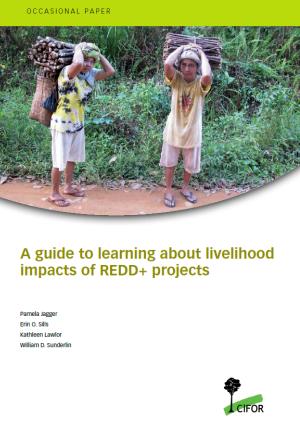
Share
Attachments
Download
"Report: A Guide to Learning About REDD+ (Dec. 2010)
http://www.profor.info/knowledge/social-impact-assessment-forest-carbon-projects...
Authors/Partners
Authors: Pamela Jagger, University of North Carolina at Chapel Hill, CIFOR; Erin O. Sills, North Carolina State University, CIFOR; Kathleen Lawlor, University of North Carolina at Chapel Hill; William D. Sunderlin, CIFOR. Partners: The work was supported by Norad, AusAID, DFID, the EU, Finland, the David and Lucile Packard Foundation, PROFOR, USAID and the US Department of Agriculture’s Forest Service.
Maximizing Learning from REDD+ Demonstration Activities (toolkit)
CHALLENGE
Lessons learned from the first generation of sub-national REDD ‘demonstration activities’ will shape the international REDD mechanism’s ability to promote policies and actions that are equitable, effective and efficient. Those lessons will also have a crucial impact on the design of the second generation of REDD strategies and activities. Yet harvesting credible, evidence-based lessons is not as straightforward as it seems.
APPROACH
This knowledge activity was carried out by CIFOR with financial support from PROFOR and other donors. It set out to ensure that first-generation REDD demonstration activities (part of the global process agreed in Bali) would draw on analysis and tools in their design and implementation which maximize learning about how to achieve effectiveness, efficiency and equitability.
RESULTS
This analysis became part of "A guide to learning about livelihood impacts of REDD+ projects" published by CIFOR in December 2010. The report examines the following:
- The case for learning from REDD+
- Counterfactual thinking for learning from REDD+ projects
- Understanding the causal mechanisms that link REDD+ interventions to outcomes
- Practical considerations for understanding the social welfare impacts of REDD+
- Moving ahead with realising REDD+: Guidance for learning about social impacts
The guide provides a unique and integrated method for evaluating the success of REDD+ at the project site level while recognizing that regional and international forces are at play in shaping local outcomes. The guide is accompanied by an executive summary and ten worksheets.
For stories and updates on related activities, follow us on twitter and facebook, or subscribe to our mailing list for regular updates.
Author : Authors: Pamela Jagger, University of North Carolina at Chapel Hill, CIFOR; Erin O. Sills, North Carolina State University, CIFOR; Kathleen Lawlor, University of North Carolina at Chapel Hill; William D. Sunderlin, CIFOR. Partners: The work was supported by Norad, AusAID, DFID, the EU, Finland, the David and Lucile Packard Foundation, PROFOR, USAID and the US Department of Agriculture’s Forest Service.
Last Updated : 06-16-2024








